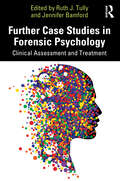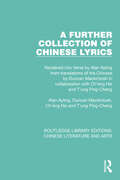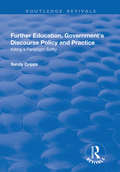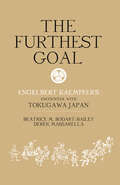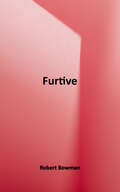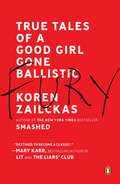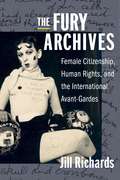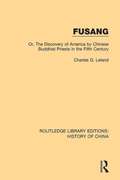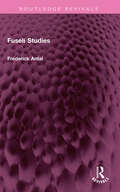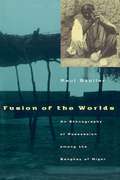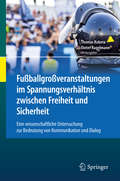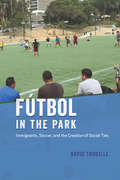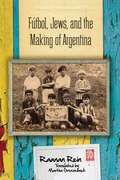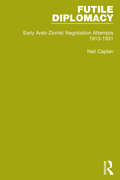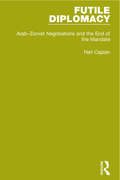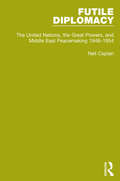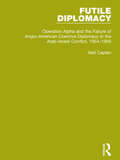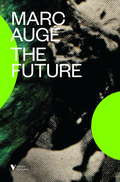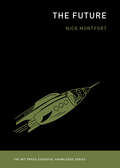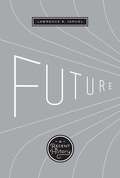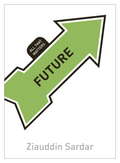- Table View
- List View
Further Adventures of the Dialectic of Sex
by Mandy Merck Stella SandfordIn these eleven essays scholars from diverse disciplines address the argument, reception, and implications of The Dialectic of Sex and make a compelling, critical case for its contemporary salience.
Further Case Studies in Forensic Psychology: Clinical Assessment and Treatment
by Jennifer Bamford Ruth J. TullyThis unique book offers valuable insights into the often-hidden world of forensic psychological assessment and intervention. It follows on from Case Studies in Forensic Psychology (2019) and presents a range of detailed clinical case studies of adults and young people across secure and community settings. The case studies represent individuals with several different forms of offending histories, such as sexual and violent offending, and various clinical diagnoses including autism and acquired brain injury. Each chapter details the individual’s personal background, offending, any relevant psychiatric or psychological diagnoses, and treatments. The chapters end with an intensive discussion on the outcomes for that case, and its wider implications. This book allows the readers to understand the on-ground clinical practice and day-to-day role of a forensic psychologist by demonstrating the work undertaken behind the empirical research and highlighting the complexities to which psychologists need to apply their expertise. It also brings together treatment models and forensic research to establish how theory translates into practice and consider whether it is effective at an individual level. Further Case Studies in Forensic Psychology is key reading for psychologists, clinicians and practitioners at any stage of their career in this rapidly expanding field. It will also be useful for students of forensic psychology and those interested in the real-life work of psychologists in forensic practice.
A Further Collection of Chinese Lyrics: Rendered into Verse by Alan Ayling from translations of the Chinese by Duncan Mackintosh in collaboration with Ch'eng Hsi and T'ung Ping-Cheng (Routledge Library Editions: Chinese Literature and Arts #14)
by Alan Ayling Duncan MackintoshThis book, first published in 1969, builds on the authors’ first selection and contains a selection of Chinese lyrics (tz’u) mainly from Sung Dynasty poets who made this verse-form lastingly popular. Two of these poets, Su Shih and Hsin Ch’i Chi, add a fresh and robust note to the traditional theme of nostalgia and separation. As in the previous volume, the Chinese original, written with a scholar’s brush, faces the English translation.
Further Education, Government's Discourse Policy and Practice: Killing a Paradigm Softly (Routledge Revivals)
by Sandy CrippsThis title was first published in 2002: By exploring a public policy process in action during the period 1944-1999, this book traces the impact of policy to the institutional level where policy becomes practice. The author investigates the development of the further education sector and reveals the process that helped shape its identity. The book provides a benchmark, combining theory with reality and evaluating current policy.
The Furthest Goal: Engelbert Kaempfers Encounter with Tokugawa Japan
by Derek Massarella Beatrice Bodart-BaileyThis important study brings together some of the best current research on Kaempfer (author of the History of Japan, also published by Curzon) for the first time and includes a close analysis of 6 key topics from the writing of the History to an interpretation of the interpreter himself.
Furtive
by Robert BowmanFurtive is the first companion novel for Washington Interactive, the Washington state geography and history curriculum.
Fury: True Tales of a Good Girl Gone Ballistic
by Koren ZailckasThe author of the New York Times bestseller Smashed "puts a voice to a generation with their own issues with rage" (San Francisco Book Review)Written when she was just twenty-three, Koren Zailckas's memoir Smashed: Story of a Drunken Girlhood became an iconic, bestselling account of her years as a teenaged blackout binge drinker. Fury picks up where Smashed left off, revealing the toxic legacy of Koren's sobriety. Without alcohol to blur her perspective, Koren finds that her good-girl personality is nothing more than a shroud for unacknowledged anger with the potential to wreak havoc on her life. A sophisticated and deeply personal chronicle, Fury hits a cultural nerve. Blazing a trail toward a healthy, empowered identity, Zailckas will astonish and free a generation of young women.
The Fury Archives: Female Citizenship, Human Rights, and the International Avant-Gardes (Modernist Latitudes)
by Jill RichardsIn the late nineteenth and early twentieth centuries, radical women’s movements and the avant-gardes were often in contact with one another, brought together through the socialist internationals. Jill Richards argues that these movements were not just socially linked but also deeply interconnected. Each offered the other an experimental language that could move beyond the nation-state’s rights of man and citizen, suggesting an alternative conceptual vocabulary for women’s rights.Rather than focus on the demand for the vote, The Fury Archives turns to the daily practices and social worlds of feminist action. It offers an alternative history of women’s rights, practiced by female arsonists, suffragette rioters, industrial saboteurs, self-named terrorists, lesbian criminals, and queer resistance cells. Richards also examines the criminal proceedings that emerged in the wake of women’s actions, tracing the way that citizen and human emerged as linked categories for women on the fringes of an international campaign for suffrage.Recovering a transatlantic print archive, Richards brings together a wide range of activists and artists, including Lumina Sophie, Ina Césaire, Rosa Luxemburg, Rebecca West, Angelina Weld Grimké, Elizabeth Gurley Flynn, Hannah Höch, Claude Cahun, Paulette Nardal, and Leonora Carrington. An expansive and methodologically innovative book, The Fury Archives argues that the relationship of women’s rights movements and the avant-gardes offers a radical alternative to liberal discourses of human rights in formation at the same historical moment.
Fusang: Or, The discovery of America by Chinese Buddhist Priests in the Fifth Century (Routledge Library Editions: History of China #7)
by Charles G. LelandThis book, first published in 1875 and reissued in 1973, analyses the limited evidence from the works of early Chinese historians that explorers from China had discovered a country they called Fusang – possibly western America, and in all probability Mexico. The original document on which Chinese historians based their accounts of Fusang was the report of a Buddhist monk called Hoei-shin, who, in the year 499 AD, returned from a long journey to the east.
Fuseli Studies (Routledge Revivals)
by Frederick AntalFirst published in 1956, Fuseli Studies deals with the many-sided artistic achievements of Zurich-born Fuseli’s baffling personality, who was one of the most erudite and renowned intellectuals of his day in Europe. The author’s intention has been to place his subject in clear historical perspective within his own epoch, and thus traces Fuseli’s contacts back to sixteenth-century mannerism and forward to twentieth-century expressionism. In this book, the social background of that absorbing period covering the artist’s working years at the turn of the nineteenth century is evoked not only in analysing his style, poised between classicism and romanticism of the age, but also accounting for its appeal and relevance to the present day. This book will be of interest to students of art, art history, European history, and literature.
Fusion of the Worlds: An Ethnography of Possession among the Songhay of Niger (None Ser.)
by Paul Stoller"This ethnography is more like a film than a book, so well does Stoller evoke the color, sight, sounds, and movements of Songhay possession ceremonies."—Choice "Stoller brilliantly recreates the reality of spirit presence; hosts are what they mediate, and spirits become flesh and blood in the 'fusion' with human existence. . . . An excellent demonstration of the benefits of a new genre of ethnographic writing. It expands our understanding of the harsh world of Songhay mediums and sorcerers."—Bruce Kapferer, American Ethnologist "A vivid story that will appeal to a wide audience. . . . The voices of individual Songhay are evident and forceful throughout the story. . . . Like a painter, [Stoller] is concerned with the rich surface of things, with depicting images, evoking sensations, and enriching perceptions. . . . He has succeeded admirably." —Michael Lambek, American Anthropologist "Events (ceremonies and life histories) are evoked in cinematic style. . . . [This book is] approachable and absorbing—it is well written, uncluttered by jargon and elegantly structured."—Richard Fardon, Times Higher Education Supplement "Compelling, insightful, rich in ethnographic detail, and worthy of becoming a classic in the scholarship on Africa."—Aidan Southall, African Studies Review
Fußballgroßveranstaltungen im Spannungsverhältnis zwischen Freiheit und Sicherheit: Eine wissenschaftliche Untersuchung zur Bedeutung von Kommunikation und Dialog
by Thomas Kubera Dieter KugelmannDas Buch präsentiert die wissenschaftlichen Ergebnisse des interdisziplinären Forschungsprojektes „Mehr Sicherheit im Fußball – Verbessern der Kommunikationsstrukturen und Optimieren des Fandialogs“. Die aus dem vom Bundesministerium für Bildung und Forschung geförderten Projekt hervorgehenden Erkenntnisse zum Status Quo der Sicherheitsgewährleistung bei Fußballgroßveranstaltungen bieten eine Reihe von Ansätzen zur Verbesserung von Kommunikationsstrukturen und -prozessen. Sie basieren auf Untersuchungen an 25 Vereinsstandorten der ersten drei Profiligen. Das Feld wurde durch Interviews mit Experten aus Fanarbeit, Fanszenen, Polizeibehörden, Vereinen und Kommunen und durch Befragungen von Stadionbesuchern, Fangruppierungen, Reisenden im Fanreiseverkehr und der Bevölkerung erschlossen. Weiterhin wurden rechtliche Stellungnahmen und Empfehlungen erarbeitet sowie eine technische Kommunikationsplattform beforscht, die eine effektive Zusammenarbeit der verschiedenen Akteure ermöglichen soll.
Fútbol in the Park: Immigrants, Soccer, and the Creation of Social Ties (Fieldwork Encounters and Discoveries)
by David TrouilleYou know the scene: amateur soccer players battling over the ball, spectators cheering from the sidelines, vendors selling their wares from carts. Over the past half century, immigration from Latin America has transformed the public landscape in the United States, and numerous communities are witnessing one of the hallmarks of this transformation: the emergence of park soccer. In Fútbol in the Park, David Trouille takes us into the world of Latino soccer players who regularly play in an upscale Los Angeles neighborhood where they are not always welcome. Together on the soccer field, sharing beers after the games, and occasionally exchanging taunts or blows, the men build relationships and a sense of who they are. Through these engrossing, revealing, and at times immortalizing activities, they forge new identities, friendships, and job opportunities, giving themselves a renewed sense of self-worth and community. As the United States becomes increasingly polarized over issues of immigration and culture, Fútbol in the Park offers a close look at the individual lives and experiences of migrants.
Fútbol in the Park: Immigrants, Soccer, and the Creation of Social Ties (Fieldwork Encounters and Discoveries)
by David TrouilleYou know the scene: amateur soccer players battling over the ball, spectators cheering from the sidelines, vendors selling their wares from carts. Over the past half century, immigration from Latin America has transformed the public landscape in the United States, and numerous communities are witnessing one of the hallmarks of this transformation: the emergence of park soccer. In Fútbol in the Park, David Trouille takes us into the world of Latino soccer players who regularly play in an upscale Los Angeles neighborhood where they are not always welcome. Together on the soccer field, sharing beers after the games, and occasionally exchanging taunts or blows, the men build relationships and a sense of who they are. Through these engrossing, revealing, and at times immortalizing activities, they forge new identities, friendships, and job opportunities, giving themselves a renewed sense of self-worth and community. As the United States becomes increasingly polarized over issues of immigration and culture, Fútbol in the Park offers a close look at the individual lives and experiences of migrants.
Fútbol in the Park: Immigrants, Soccer, and the Creation of Social Ties (Fieldwork Encounters and Discoveries)
by David TrouilleYou know the scene: amateur soccer players battling over the ball, spectators cheering from the sidelines, vendors selling their wares from carts. Over the past half century, immigration from Latin America has transformed the public landscape in the United States, and numerous communities are witnessing one of the hallmarks of this transformation: the emergence of park soccer. In Fútbol in the Park, David Trouille takes us into the world of Latino soccer players who regularly play in an upscale Los Angeles neighborhood where they are not always welcome. Together on the soccer field, sharing beers after the games, and occasionally exchanging taunts or blows, the men build relationships and a sense of who they are. Through these engrossing, revealing, and at times immortalizing activities, they forge new identities, friendships, and job opportunities, giving themselves a renewed sense of self-worth and community. As the United States becomes increasingly polarized over issues of immigration and culture, Fútbol in the Park offers a close look at the individual lives and experiences of migrants.
Fútbol, Jews, and the Making of Argentina
by translated by Martha Grenzeback Raanan ReinIf you attend a soccer match in Buenos Aires of the local Atlanta Athletic Club, you will likely hear the rival teams chanting anti-Semitic slogans. This is because the neighborhood of Villa Crespo has long been considered a Jewish district, and its soccer team, Club Atlético Atlanta, has served as an avenue of integration into Argentine culture. Through the lens of this neighborhood institution, Raanan Rein offers an absorbing social history of Jews in Latin America. Since the Second World War, there has been a conspicuous Jewish presence among the fans, administrators and presidents of the Atlanta soccer club. For the first immigrant generation, belonging to this club was a way of becoming Argentines. For the next generation, it was a way of maintaining ethnic Jewish identity. Now, it is nothing less than family tradition for third generation Jewish Argentines to support Atlanta. The soccer club has also constituted one of the few spaces where both Jews and non-Jews, affiliated Jews and non-affiliated Jews, Zionists and non-Zionists, have interacted. The result has been an active shaping of the local culture by Jewish Latin Americans to their own purposes. Offering a rare window into the rich culture of everyday life in the city of Buenos Aires created by Jewish immigrants and their descendants, Fútbol, Jews, and the Making of Argentina represents a pioneering study of the intersection between soccer, ethnicity, and identity in Latin America and makes a major contribution to Jewish History, Latin American History, and Sports History.
Futile Diplomacy, Volume 1: Early Arab-Zionist Negotiation Attempts, 1913-1931 (Futile Diplomacy)
by Neil CaplanMost students of the history of Arab-Jewish relations have come to take for granted the stubborn resistance of the continuing dispute to any form of lasting and ‘reasonable’ solution. This book, first published in 1983, examines early Arab-Zionist negotiating experience with the assumption that this has direct relevance to our understanding of the possible outcomes of diplomatic approaches to resolving the conflict. Its main purpose is to assemble (half of the book consists of original souce documents) and discuss some of the raw material which may help readers focus more clearly on the origins of the conflict, and perhaps to eliminate some recurring fallacies about its development and the prospects for its resolution. An examination of the period 1913 to 1931 reveals of wealth of previous negotiating experience which is today largely forgotten, and indicates that there was little or no movement of any of the parties in the direction of modifying its basic minimum demands and aspirations.
Futile Diplomacy, Volume 2: Arab-Zionist Negotiations and the End of the Mandate (Futile Diplomacy)
by Neil CaplanWith half of this book, first published in 1986, being given over to Neil Caplan’s detailed analysis and half to the collection of the original documents, the second volume in Futile Diplomacy provides another essential resource for the understanding of the Arab-Israeli conflict. In Arab-Zionist Negotiations and the End of the Mandate a key period in the negotiations between the two parties is examined, as attempts were made by both sides to reach a peaceful, negotiated settlement.
Futile Diplomacy, Volume 3: The United Nations, the Great Powers and Middle East Peacemaking, 1948-1954 (Futile Diplomacy)
by Neil CaplanThis book, first published in 1997, provides a careful and balanced behind-the-scenes account of the intricate diplomatic activity of the period between the first and second Arab-Israeli wars. The author examines the recurring deadlocks in terms of the motives and calculations of the various parties, and reveals how new incentives of pressures offered by outsiders proved incapable of reversing the serious deterioration of Arab-Israeli relations as the region headed for war at Suez. The text of this volume comprises both an in-depth analysis of the period and events, and a selection of primary documents from archival sources.
Futile Diplomacy, Volume 4: Operation Alpha and the Failure of Anglo-American Coercive Diplomacy in the Arab-Israeli Conflict, 1954-1956 (Futile Diplomacy)
by Neil CaplanThis book, first published in 1997, focuses on the Anglo-American cooperation which began during the relatively uneventful years 1953 and 1954, and which led to a covert operation, code-named 'Alpha', which aimed – unsuccessfully – at convincing Egyptian and Israeli leaders to consider a settlement through secret negotiations. As with the other three volumes that make up Futile Diplomacy, this volume comprises Dr Caplan's expert in-depth analysis with a wealth of primary source documents, making this a key reference source in the study of the Arab-Israeli conflict.
Futile Pleasures: Early Modern Literature and the Limits of Utility
by Corey McEleneyHonorable Mention, 2018 MLA Prize for a First BookAgainst the defensive backdrop of countless apologetic justifications for the value of literature and the humanities, Futile Pleasures reframes the current conversation by returning to the literary culture of early modern England, a culture whose defensive posture toward literature rivals and shapes our own.During the Renaissance, poets justified the value of their work on the basis of the notion that the purpose of poetry is to please and instruct, that it must be both delightful and useful. At the same time, many of these writers faced the possibility that the pleasures of literature may be in conflict with the demand to be useful and valuable. Analyzing the rhetoric of pleasure and the pleasure of rhetoric in texts by William Shakespeare, Roger Ascham, Thomas Nashe, Edmund Spenser, and John Milton, McEleney explores the ambivalence these writers display toward literature’s potential for useless, frivolous vanity. Tracing that ambivalence forward to the modern era, this book also shows how contemporary critics have recapitulated Renaissance humanist ideals about aesthetic value. Against a longstanding tradition that defensively advocates for the redemptive utility of literature, Futile Pleasures both theorizes and performs the queer pleasures of futility. Without ever losing sight of the costs of those pleasures, McEleney argues that playing with futility may be one way of moving beyond the impasses that modern humanists, like their early modern counterparts, have always faced.
The Future
by John Howe Marc AugeFor Marc Augé, best-selling author of Non-Places, the prevailing idea of "the Future" rests on our present fears of the contemporary world. It is to the future that we look for redemption and progress; but it is also where we project our personal and apocalyptic anxieties. By questioning notions of certainty, truth, and totality, Augé finds ways to separate the future from our eternal, terrified present and liberates the mind to allow it to conceptualize our possible futures afresh.From the Trade Paperback edition.
The Future: The Commodore Amiga (The MIT Press Essential Knowledge series)
by Nick MontfortHow the future has been imagined and made, through the work of writers, artists, inventors, and designers.The future is like an unwritten book. It is not something we see in a crystal ball, or can only hope to predict, like the weather. In this volume of the MIT Press's Essential Knowledge series, Nick Montfort argues that the future is something to be made, not predicted. Montfort offers what he considers essential knowledge about the future, as seen in the work of writers, artists, inventors, and designers (mainly in Western culture) who developed and described the core components of the futures they envisioned. Montfort's approach is not that of futurology or scenario planning; instead, he reports on the work of making the future—the thinkers who devoted themselves to writing pages in the unwritten book. Douglas Engelbart, Alan Kay, and Ted Nelson didn't predict the future of computing, for instance. They were three of the people who made it.Montfort focuses on how the development of technologies—with an emphasis on digital technologies—has been bound up with ideas about the future. Readers learn about kitchens of the future and the vision behind them; literary utopias, from Plato's Republic to Edward Bellamy's Looking Backward and Charlotte Perkins Gilman's Herland; the Futurama exhibit at the 1939 New York World's Fair; and what led up to Tim Berners-Lee's invention of the World Wide Web. Montfort describes the notebook computer as a human-centered alterative to the idea of the computer as a room-sized “giant brain”; speculative practice in design and science fiction; and, throughout, the best ways to imagine and build the future.
Future: A Recent History
by Lawrence R. SamuelThe history of our attitudes toward the possibilities of tomorrow:&“A fascinating trek through American future visions from the 1920s to the present.&” —Lori C. Walters, Ph.D., University of Central Florida The future is not a fixed idea but a highly variable one that reflects the values of those who are imagining it. By studying the ways that visionaries imagined the future—particularly that of America—in the past century, much can be learned about the cultural dynamics of the times. In this social history, Lawrence R. Samuel examines the future visions of intellectuals, artists, scientists, businesspeople, and others to tell a chronological story about the history of the future in the past century. He defines six separate eras of future narratives from 1920 to the present day, and argues that the milestones reached during these years—especially related to air and space travel, atomic and nuclear weapons, the women&’s and civil rights movements, and the advent of biological and genetic engineering—sparked the possibilities of tomorrow in the public&’s imagination, and helped make the twentieth century the first century to be significantly more about the future than the past. The idea of the future grew both in volume and importance as it rode the technological wave into the new millennium, and the author tracks the process by which most people, to some degree, have now become futurists as the need to anticipate tomorrow accelerates.
Future: All That Matters
by Ziauddin SardarIn Future: All That Matters, Ziauddin Sardar shows that thinking and speculating about the future has always been a part of human history, but exploring the futures in a systematic and scientific way is a recent phenomenon. What is known variously as 'futures studies', 'futurology' or 'foresight' only emerged as a discipline during the last few decades. The study of the future, however, is not only about 'predicting' or 'forecasting' the future, which is always a perilous exercise. It is also about appreciating the potentials and possibilities, as well as risks and threats, lurking over the horizon. It can enable us both to avoid the dangers as well as shape a viable and desirable future.This book explores the exciting field of futures studies, and shows how knowledge of the future is acquired and put into practice. We examine various methods for studying the future, with the emphasis not so much on predicting specific events but on delineating alternative paths to the future. We look at some celebrated readings of the future as well as case studies where exploration of the future has been used to shape policy and planning in businesses and communities, international organisations and regional institutions, and interest and lobby groups. Finally, the book suggests why and how in an increasingly complex, uncertain and diverse world, the study of the future can help people recover their agency and help them to create the world in which they wish to live. This accessible and readable book will appeal both to students and general readers, giving a fascinating introduction to thinking about the future - and what matters most about it.

